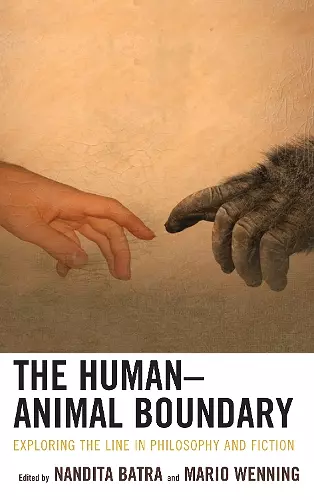The Human–Animal Boundary
Exploring the Line in Philosophy and Fiction
Mario Wenning editor Nandita Batra editor
Format:Paperback
Publisher:Bloomsbury Publishing PLC
Published:22nd Sep '21
Currently unavailable, and unfortunately no date known when it will be back
This paperback is available in another edition too:
- Hardback£90.00(9781498557825)

Throughout the centuries philosophers and poets alike have defended an essential difference—rather than a porous transition—between the human and animal. Attempts to assign essential properties to humans (e.g., language, reason, or morality) often reflected ulterior aims to defend a privileged position for humans..
This book shifts the traditional anthropocentric focus of philosophy and literature by combining the questions “What is human?” and “What is animal?” What makes this collection unique is that it fills a lacuna in critical animal studies and the growing field of ecocriticism. It is the first collection that establishes a productive encounter between philosophical perspectives on the human–animal boundary and those that draw on fictional literature. The objective is to establish a dialogue between those disciplines with the goal of expanding the imaginative scope of human-animal relationships. The contributions thus do not only trace and deconstruct the boundaries dividing humans and nonhuman animals, they also present the reader with alternative perspectives on the porous continuum and surprising reversal of what appears as human and what as nonhuman.
Batra and Wenning edited and selected this excellent, diverse collection of scholarly essays that reevaluate or break human-nonhuman boundaries. The latest volume in Lexington's 'Ecocritical Theory and Practice' series, the book provides a welcome complement to the resulting discourse at two international conferences by the same name, held at the editors' home universities in Puerto Rico and Macau. The innovative essays demonstrate that boundaries have two sides. Humans and animals are different, mostly in self-appointed ways, but also markedly similar in terms of culture and innovation. For example, essays on Aesop’s fables and the Ramayana epic argue that humans are not only similar to some other animals but are, in certain cases, even beholden to them. Narratives of difference, such as Cartesian subjectivism and Heideggerian phenomenology, are juxtaposed with counter narratives from ancient texts and modern biology to an enlightening effect. Summing Up: Recommended. * Choice Reviews *
From Aesop’s and Heidegger’s animals to McKibben’s and Bekoff’s anthropocene, the dividing line between homo sapiens and the world’s other species has been supported and abolished, attacked and embraced. As ecocriticism has developed into a discipline, scholars have seen this same human/animal distinction as central to our understanding of ecology and the rise of environmentalism. Batra and Wenning bring together essays that make clear why this debate is so central to our understanding of the role of animals in human life and the role of humans in the lives of animals. -- Ashton Nichols, Beach ’65 Distinguished Professor in Sustainability Studies and Professor of English, Dickinson College, and author of Beyond Romantic Ecocriticism: Urbanatural Roosting and Romantic Natural Histories: Wordsworth, Darwin and Others
ISBN: 9781498557849
Dimensions: 218mm x 152mm x 18mm
Weight: 372g
242 pages